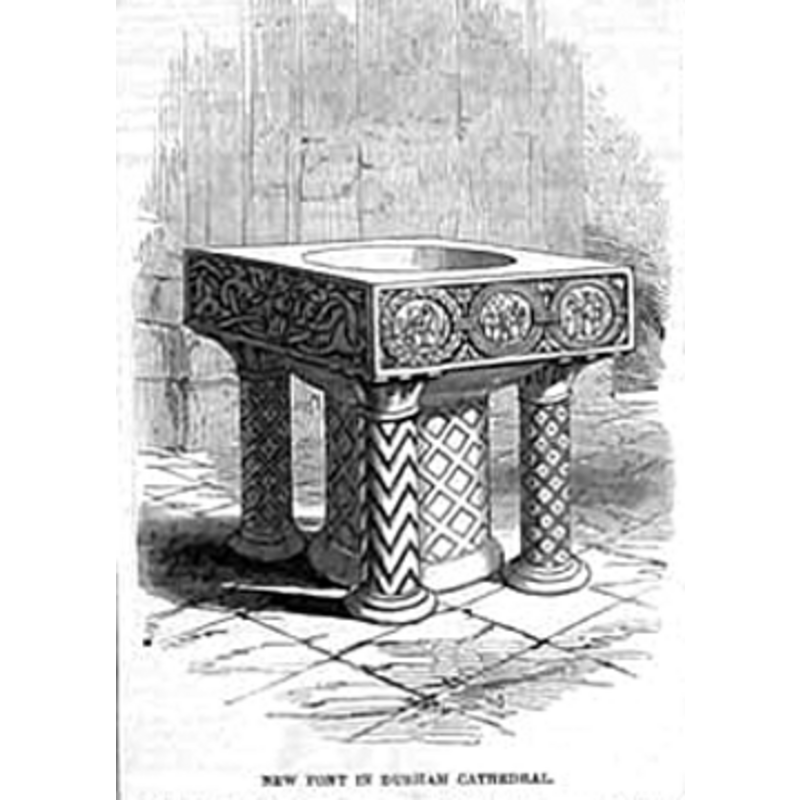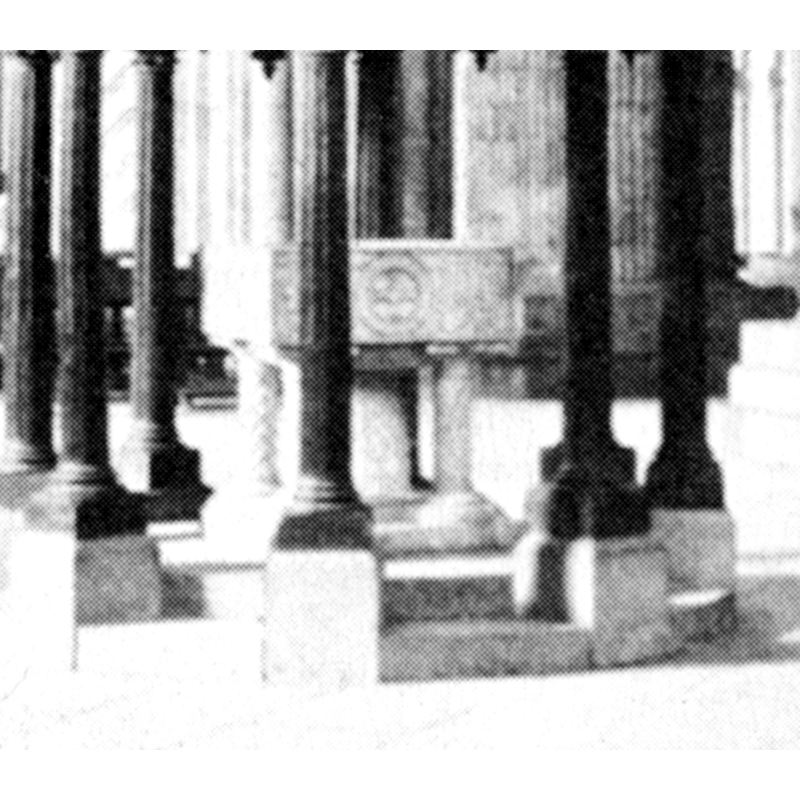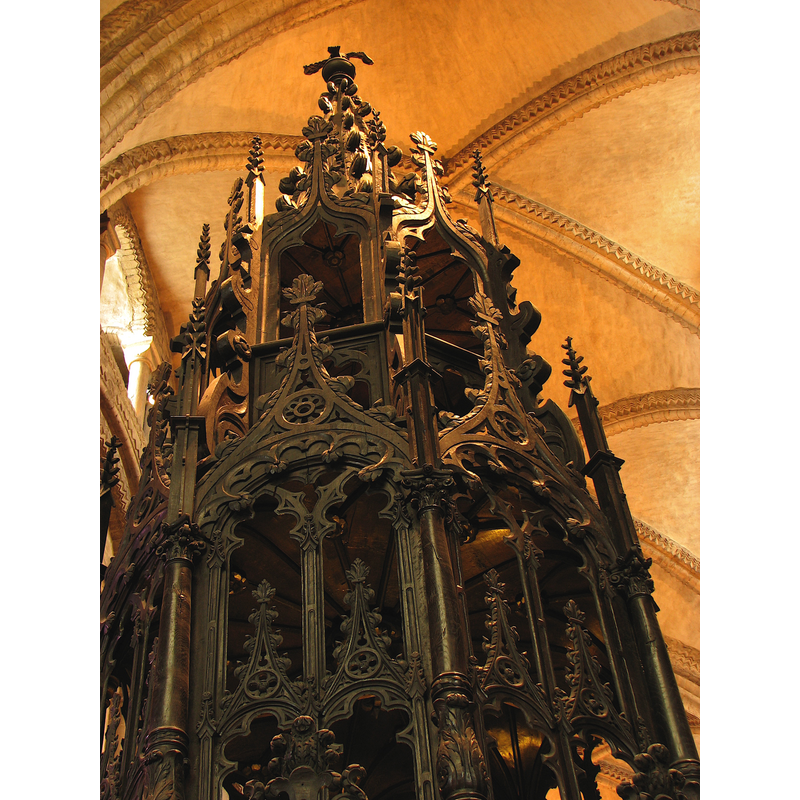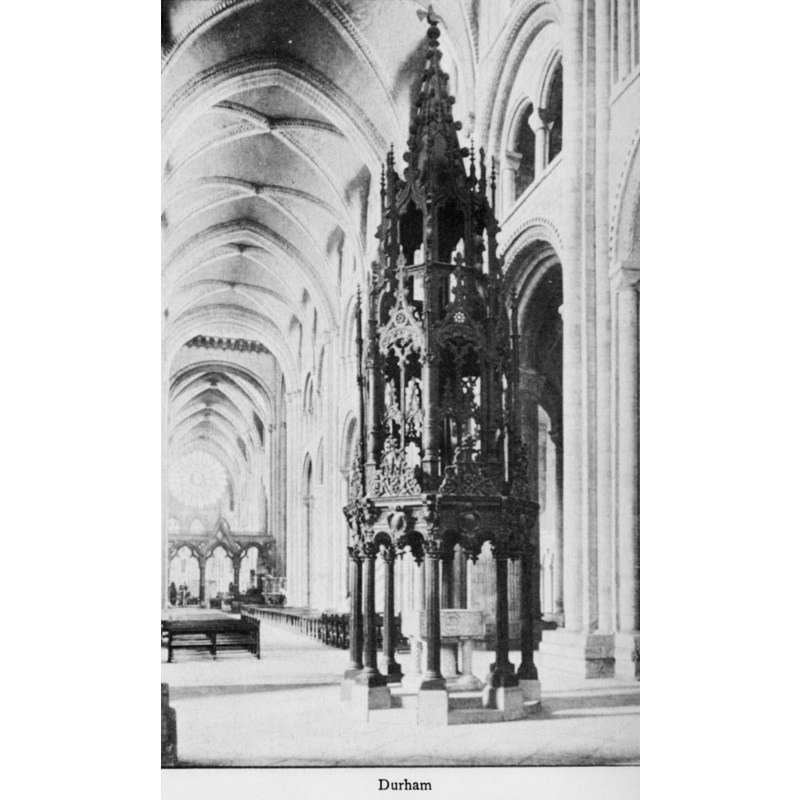Durham No. 2

Image copyright © [in the public domain]
PD
Results: 11 records
B01: design element - patterns - gadrooned or ribbed
LB01: design element - motifs - moulding
R01: design element - motifs - roll moulding
view of font
view of font
Scene Description: NB: the font seen here is the font moved twice to Durham Cathedral -- it is seen here, in the interior of Pittington parish church, with the much humbler font cover of Pittington
Copyright Statement: Image copyright © [in the public domain]
Image Source: digital image of an illustration in Bond (1908)
Copyright Instructions: PD
view of font
view of font and canopy, baldachin - canopy
Copyright Statement: Image copyright © Durham County Council, 2008
Image Source: reproduction from a ca. 1925 Raphael Tuck B&W postcard [http://www.durham.gov.uk/durhamcc/DRE.nsf/DREPicture?readform&PIC=dre/m/00525.jpg&NAME=Durham+Cathedral,+interior,+font+cover&IMGID=M914&KEYWORD=Fonts] [accessed 29 November 2008]
Copyright Instructions: PERMISSION NOT AVAILABLE -- IMAGE NOT FOR PUBLIC USE
view of font and canopy, baldachin - canopy
Scene Description: the 17th-century font shown under the canopy
Copyright Statement: Image copyright © British National Image Library, 2008
Image Source: 1950 B&W photograph in the British National Image Library [http://www.images.british-towns.net/album/image_display.asp?GetPic=469] [accessed 29 November 2008]
Copyright Instructions: PERMISSION NOT AVAILABLE -- IMAGE NOT FOR PUBLIC USE
view of font and canopy, baldachin - canopy
Scene Description: the 19th-century neo-Norman font shown under the canopy
Copyright Statement: Image copyright © Durham County Council, 2008
Image Source: Hartmann coloured postcard postmarked 1904 in the collection at Durham County Council [http://www.durham.gov.uk/durhamcc/DRE.nsf/DREDetail?readform&NAME=Durham+Cathedral,+interior,+font+cover&IMGID=M951&KEYWORD=Fonts] [accessed 29 November 2008]
Copyright Instructions: PERMISSION NOT AVAILABLE -- IMAGE NOT FOR PUBLIC USE
view of font canopy, baldachin - canopy
INFORMATION
FontID: 09850DUR
Object Type: Baptismal Font1
Church/Chapel: Cathedral Church of Christ, Blessed Mary the Virgin and St. Cuthbert
Church Patron Saints: Jesus Christ, St. Mary & St. Cuthbert [aka Cubertus]
Church Location: Durham, County Durham, DH1 3EH
Country Name: England
Location: Durham, North East
Ecclesiastic Region: Diocese of Durham
Font Location in Church: Inside the church, in the nave, W end
Date: 1663
Century and Period: 17th century(mid), Stuart
Font Notes:
Click to view
Mackenzie & Ross (1834) note: "The font was the work of Dean Hunt and the chapter. The first child baptised in it was 'Richard sonne of Mr. John Robson, parson of Morpethe, 24th March, 1621.' It is described by a traveller who visited Durham in 1634, as 'not to be paralleled in our land. It is eight square, with an iron grate raysed two yards every square. Within it is a fayre ascent of diverse steps. The cover opens like a four quartered globe, the stone is of branched marble, and the story is that of St. John baptizing our blessed Savior, and ye four evangelists curiously done and richly painted within the globe, all about so artificially wrought and carv'd with such variety of joyners work, as makes all the beholders thereof to admire.' The railing and much of the ornamental work has disappeared; but it is still a magnificent structure." [NB: a footnote in Mackenzie & Ross (ibid.) mentions the font having been probably removed "during the imprisonment of the Scots in 1650"]. The 17th-century font and the older canopy are described in Fordyce (1857), who notes that "the font, with its canopy, was removed in 1845, to a recess under the south tower of the western cross aisle or transept, and a new font. More in keeping with the Norman style of the building, introduced. It is made of Caen stone; the upper part is square, the north and south side being decorated with roundels, sculptured with scenes from the life of St. Cuthbert; on the side facing the east is a figure of the saints holding the head of King Oswald, and on that facing the west, St. Cuthbert's cross, with Norman foliage filling up the panelling of each. It has no covering, and is supported by five short pillars […] The workmanship is beautifully executed by Mr. White of London. The old font was given to Rev. Mr. Miller, for Pittington church, but the canopy remains near the door of the south entrance to the Galilee" [NB: this font was returned to the Cathedral about 90 years later, when Pitttington discovered its own original font -- cf. Index entry for Pittington for details]. Murray (1873) notes three related objects in this church: "r[igh]t of the doorway is the font, adorned with incidents from the life of St. Cuthbert, taken from an illuminated MS. In the possession of Sir Wm. Lawson of Brough. This supplies the place of an older font, now removed to Piddington. Attached to the pillar nearest the font was a holy-water stoup of blue marble, now destroyed". Murray (ibid.) further notes "the richly carved cover of the font (now at Piddington) given by Bp. Cosin". The Victoria County History (Durham, vol. 3, 1928) notes: "The site has been continuously occupied by a church from 995, when the body of St. Cuthbert was brought hither after many wanderings, and a temporary structure was erected over it. This was superseded by a church of stone begun by Bishop Aldhun in 996, and known as the White Church. Aldhun's church was standing at the time of the Conquest, but excavation has failed to reveal any trace of it. [...] The church which stands to-day was begun, as Simeon of Durham tells us, in 1093 by Bishop William of St. Calais (1080–1096). [...] The whole was brought to completion, except for the upper stories of the western towers, in 1133." The VCH entry for the cathedral (ibid.) reports an old font destroyed in the second Bishops' War of 1640, as well as a "font-tabernacle" [i.e., font cover] that was commissioned (?) by Bishop Cosin (1660-1672). The VCH additional information on the cathedral (ibid.) notes: "The present font dates from 1846 and has a rectangular bowl of Caen stone supported on pillars, in the style of the 12th century. It took the place of a white marble font of chalice type erected by Cosin in 1663, which was given in 1846 to Pittington Church, where it now is. Cosin's lofty canopy of tabernacle work, however, survived all the 19th-century restorations. It is a splendid piece of work, standing on eight fluted pillars with composite capitals, the lower stage being of classic, and the upper stages of pronounced Gothic design." On the fate of the other fonts the VCH entry odds: "Of the pre-Reformation font no proper record seems to have been preserved. Peter Smart described the font in use in Elizabethan times as 'comely, like to that of St. Paul's at London and in other cathedrals.' This was replaced by one of marble about 1621, which was described thirteen years later as 'not to be paralleled in the land.' It was 'eight square, with an iron grate raised two yards every square,' and all about it was ' artificially wrought and carved with such variety of joiners work as makes all the beholders thereof to admire.' Raine, Durh. Cath. 15. Smart called it 'a mausoleum, towering up to the roof of the church, a most sumptuous fabric and costly, partly of wood and partly of stone.' This font and cover were destroyed by the Scotch prisoners in 1650." Listed in the World Heritage List Nomination: Durham Cathedral and Castle, No. 370 of 1986 [whc.unesco.org/sites/nom/uk-370.htm]: "17th century font with a magnificent carved canopy. This, like the canopies of the stalls in the choir, dates to the 17th century". This source refers to the Restoration and the installation of John Cosin as bishop of Durham (1660-1672), who "provided the choir stalls now in position, the font and font cover" among many other furnishings. Post-Reformation, chalice-shaped white marble font of Italian-influenced design. The Illustrated London News (Nov. 14, 1846: 316) reports on the installation of a new font in Durham Cathedral; the font is illustrated with an engraving: it is a neo-Norman table-top with decorated basin sides; the base conists of five supports, a central shaft and four outer colonnettes, the latter with foliated capitals, all five with moulded bases; each of the columns has individual decoration. Bond (1908) states that it was installed at Durham Cathedral by Bishop John Costin but later replaced by a pseudo-Norman font of Victorian manufacture. The Cathedral appears to have changed the font under the canopy several times. A coloured postcard postmarked 1904 in the collection at Durham County Council [http://www.durham.gov.uk/durhamcc/DRE.nsf/DREDetail?readform&NAME=Durham+Cathedral,+interior,+font+cover&IMGID=M951&KEYWORD=Fonts] [accessed 29 November 2008] shows the neo-Norman font under the canopy. The British National Image Library Index has a B&W photograph from 1950 in which the font shown under the canopy is the 17th-century one, and so does Randall (1980), who shows the same post-Reformation font and the huge oak (?) canopy in the Cathedral -without a date- and dates the font and the canopy to ca. 1663. Pevsner (1983) writes: "Font. 1663. A beautifully simple, yet elegant example of the baluster type, white marble with a gadrooned bowl. -- The font canopy is one of the most gorgeous of the many pieces of elborate woodwork made for Bishop Cosin during the eleven years that he held the see at Durham. It stands more than 40 ft. high and is at the base about 9 ft. across. It is octagonal, with fluted composite columns, an acanthus frieze, a cartouche with a pendant on each side at groun-floor level. That kind of post-Restoration, classical decoration goes well with the shape of the font itself. But above, between the next tier of unfluted baluster-like columns, Gothic tracery and Gothic crocketed gables appear, and from there it goes entirely Gothic with a tall traceried canopy crowned with a crocketed spire. The canopy is almost exactly like the subsidiary canopies on the Sedgefield screen in form, but more Baroque, with flickering movement in the carving of the crockets etc." The Durham Cathedral & Castle web site [www.dur.ac.uk] gives the date of the erection of the canopy as 1663 and describes it thus: "This Canopy, which is over 12 metres high, is octagonal with fluted columns and a frieze in the shape of leaves at ground floor level." [cf. Index entries for Pittington for the movements of the 17th font between Pittington and Durham Cathedral]. [NB: Pevsner (1983) footnotes his entry for the cathedral font [cf. supra] with the following: "Salvin's Norman-style font took its place from 1846 until 1935, according to Dr Allibone." [cf. Index entry for Durham No. 9 for the earlier font of this cathedral].
COORDINATES
Church Latitude & Longitude Decimal: 54.773611, -1.576111
Church Latitude & Longitude DMS: 54° 46′ 25″ N, 1° 34′ 34″ W
UTM: 30U 591593 6070529
MEDIUM AND MEASUREMENTS
Material: stone, marble (white)
Font Shape: hemispheric (mounted)
Basin Interior Shape: round
Basin Exterior Shape: round
INSCRIPTION
Inscription Text: [1663]
Inscription Source: [cf. FontNotes]
LID INFORMATION
Date: 1663
Material: wood
Notes: [cf. FontNotes]
REFERENCES
Victoria County History [online], University of London, 1993-. Accessed: 2012-03-07 00:00:00. URL: https://www.british-history.ac.uk.
Victoria County History [online], University of London, 1993-. Accessed: 2012-03-07 00:00:00. URL: https://www.british-history.ac.uk.
Victoria County History [online], University of London, 1993-. Accessed: 2012-03-07 00:00:00. URL: https://www.british-history.ac.uk.
Bond, Francis, Fonts and Font Covers, London: Waterstone, 1985 c1908
Fordyce, William, The History and Antiquities of the county palatine of Durham; comprising a condensed account of its natural, civil, and ecclesiastical history […], Newcastle, London and Edinburgh: A. Fullarton and Co., 1857
Mackenzie, Eneas, An historical, topographical, and descriptive view of the county palatine of Durham: comprehending the various subjects of natural, civil, and ecclesiastical geography, agriculture, mines, manufactures […], Newcastle-upon-Tyne: Mackenzie & Dent, 1834
Murray, John (the firm), A handbook for travellers in Durham and Northumberland, London: John Murray ; printed by William Clowes and Sons, 1873
Pevsner, Nikolaus, County Durham, Harmondsworth: Penguin Books, 1983
Pugin, Augustus Northmore Welby, The Present State of Ecclesiastical Architecture in England, London: Charles Dolman, 1843
Randall, Gerald, Church Furnishing & Decoration in England and Wales, London: B.T. Batsford Ltd., 1980




